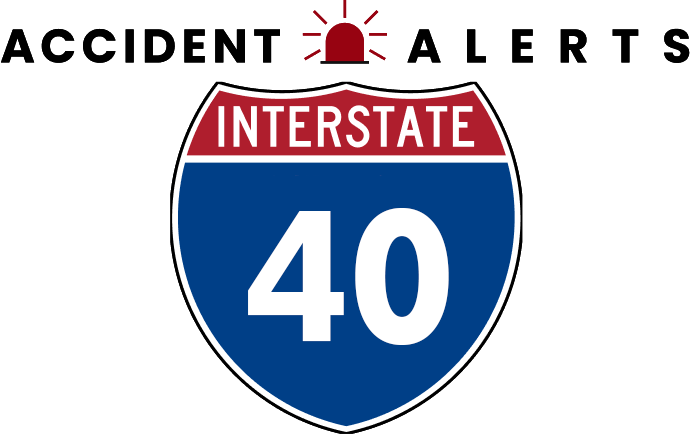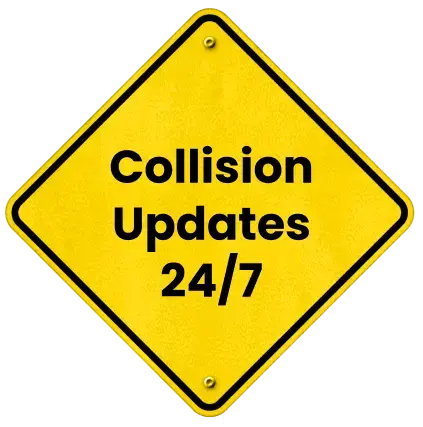
Latest Accidents
More IncidentsInterstate 40 Accident News and Resources
Stretching more than 2,500 miles across the United States, Interstate 40 is one of America’s most important east-west highways. Beginning in Barstow, California, and ending in Wilmington, North Carolina, I-40 travels through eight states and connects major cities, rural communities, and regional transportation hubs. Known for its role in both commerce and tourism, Interstate 40 carries millions of travelers and commercial vehicles every year.
While I-40 offers a vital link across the country, it also presents significant dangers for drivers. High traffic volumes, unpredictable weather, ongoing construction, and long stretches of rural highway contribute to a high number of accidents along the route. Whether traveling through the desert stretches of Arizona, the wide plains of Oklahoma, or the busy urban centers of Tennessee and North Carolina, drivers must remain alert and prepared for sudden changes in road conditions.
Accidents can happen anywhere along Interstate 40 — often with little warning. Understanding how to respond after a crash, how to obtain a police accident report, and how to stay safe on long-distance journeys is essential for all drivers who travel this major interstate.
This resource guide provides essential information about navigating accidents on Interstate 40, including reporting procedures, common accident causes, travel safety tips, and more.
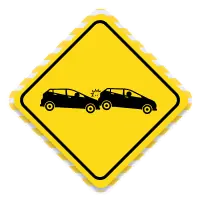
Rear-end
Collisions:
This type of accident occurs when a vehicle hits the vehicle in front of it on the roadway. There are many reasons why this type of accident takes place, often due to driver error while on the interstate..
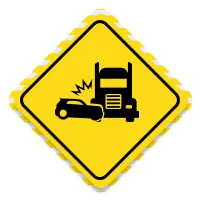
Truck
Accidents:
Roughly 50% of truck accidents on the interstate take over four hours to clean up. Extensive delays along these narrow roadways make traveling on the interstate even more hazardous.
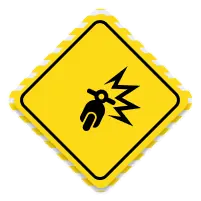
Motorcycle
Accidents:
When a motorcycle accident occurs the results can be severe for a rider. That's because motorcycles & their riders have little protection when involved in an accident with a larger car or truck.
States Along Interstate 40
Interstate 40 crosses eight states, connecting a wide range of landscapes, climates, and driving conditions. From the deserts of the Southwest to the rolling hills of the East, each section of I-40 presents unique travel challenges for drivers. Heavy traffic, extreme weather, rural isolation, and busy urban interchanges can all contribute to accidents along this vital corridor.
States that Interstate 40 travels through include:
- California: I-40 begins in Barstow, California, providing a primary eastbound link from the Mojave Desert toward Arizona.
- Arizona: Crossing northern Arizona, I-40 passes through cities like Flagstaff and Kingman, replacing much of the historic Route 66 path.
- New Mexico: In New Mexico, I-40 runs through Albuquerque and across vast desert and plateau regions.
- Texas: I-40 travels through the Texas Panhandle, passing through Amarillo and connecting to critical freight and travel routes.
- Oklahoma: A major east-west route in Oklahoma, I-40 serves Oklahoma City and many rural towns across the state.
- Arkansas: In Arkansas, I-40 connects Little Rock to smaller cities and agricultural regions across the state.
- Tennessee: I-40 crosses the entire width of Tennessee, linking major cities like Memphis, Nashville, and Knoxville.
- North Carolina: The highway ends in Wilmington, North Carolina, after passing through Asheville, Winston-Salem, and Raleigh.
Each state brings different driving environments, from open desert highways to congested urban stretches, making it essential for travelers to stay alert and adapt to local conditions.
Common Causes of Accidents on Interstate 40
Accidents along Interstate 40 can happen for many reasons, often depending on the specific region drivers are traveling through. In busy cities like Nashville and Oklahoma City, congestion and distracted driving lead to frequent collisions. In rural stretches across Arizona, New Mexico, and Texas, high speeds and fatigue often contribute to serious crashes.
Some of the most common causes of accidents along Interstate 40 include:
- Speeding: Long, open stretches in rural states often encourage drivers to exceed posted speed limits, reducing reaction times and increasing crash severity.
- Distracted Driving: Mobile device use, adjusting navigation systems, and other distractions contribute to a large number of accidents along both urban and rural sections of I-40.
- Fatigue: Drivers traveling long distances across sparsely populated areas, especially in New Mexico and Texas, are at higher risk of falling asleep at the wheel.
- Weather Conditions: Heavy rain, fog, ice, and high winds can make driving treacherous, particularly in mountainous regions and through winter storms.
- Construction Zones: Ongoing roadwork projects can create sudden lane shifts, reduced speed zones, and confusing detours, increasing the risk of collisions.
- Heavy Commercial Traffic: I-40 is a central freight corridor, and the high volume of semi-trucks can contribute to accidents, particularly during merging, lane changes, or adverse weather.
Understanding these risks can help drivers stay more alert and cautious while traveling across the varied landscapes of Interstate 40.
Weather and Terrain Challenges on Interstate 40
Interstate 40 spans a wide range of terrain types and climate zones, exposing drivers to numerous weather-related hazards throughout the year. Being prepared for sudden changes in conditions is essential for anyone traveling along this major route.
Common weather and terrain hazards on I-40 include:
How an Attorney Can Help After an Interstate 40 Accident
After a serious accident on Interstate 40, drivers and passengers often face many challenges, from recovering physically to handling complicated insurance claims. Consulting with an experienced personal injury attorney can provide valuable support during this stressful time. An attorney can review the official police accident report, gather substantial evidence, and ensure that all aspects of the accident are carefully documented.
In addition to investigating the facts of the crash, an attorney can help negotiate with insurance companies and fight for fair compensation for medical expenses, lost income, and property damage. Legal representation becomes especially important when dealing with multi-vehicle accidents, commercial truck collisions, or disputes about who was at fault.
Even if you are unsure whether legal action is necessary, speaking with an attorney after a major crash can help you better understand your rights and options. Having an advocate on your side can make a significant difference as you work to recover and move forward after an accident on I-40.
Stay Informed and Stay Safe
Interstate 40 remains one of the busiest and most important highways in the United States, connecting travelers and commercial traffic from coast to coast. While the road offers countless opportunities to explore different parts of the country, it also presents real dangers that require preparation, caution, and quick thinking behind the wheel.
At i40accidents.com, we are committed to providing helpful information about accident procedures, crash reporting, and travel safety. Our goal is to help drivers stay informed, make smart choices, and protect themselves and their families when traveling along this vital corridor.
Whether you are commuting to work, heading on a cross-country trip, or transporting goods across the country, staying alert and planning ahead are essential for a safe journey on I-40.
Interstate 40 Crash Reports & Legal Help — Frequently Asked Questions
Stretching over 2,500 miles across the United States, Interstate 40 is one of the longest and busiest highways in the country. From California to North Carolina, I-40 connects major cities, small towns, and rural regions with their own traffic conditions, hazards, and police agencies. Unfortunately, with so many vehicles on the road every day, accidents are a common occurrence.
Whether you’ve been involved in a crash or are simply planning to travel along I-40, it’s essential to understand what to do after an accident, how to get a police report, and when to seek legal advice. This FAQ page covers the most common questions we hear from drivers navigating I-40, no matter where they are in the country.
In addition to understanding the procedural aspects following an accident, it’s also important to prioritize safety on the road. Awareness of common hazards specific to I-40 can help reduce the risk of accidents. Factors such as weather conditions, heavy truck traffic, and road construction zones are prevalent along this extensive highway. By staying alert and driving defensively, motorists can minimize their chances of being involved in a crash. Remember, being prepared and knowing how to respond can make a significant difference in the aftermath of an accident.
Frequently Asked Questions
What should I do immediately after an accident on I-40?
Pull over safely if possible and call 911. Exchange insurance and contact information with other drivers, and take photos of the vehicles, surroundings, and any injuries. Always wait for law enforcement to arrive so a crash report can be filed. If you’re injured, prioritize getting medical attention — even for what may seem like minor injuries. They could worsen or become key to your claim later.
How do I get a copy of my I-40 police crash report?
The state highway patrol or local police typically file crash reports. You can usually request them online, by mail, or in person. Most states now have digital portals, but some smaller departments may require phone or in-person requests. Visit our state-specific pages for exact instructions based on where your accident occurred.
Who investigates accidents on I-40?
The State Highway Patrol (e.g., California Highway Patrol, Oklahoma Highway Patrol, etc.) usually responds in rural areas. In city limits, the local police department may take over the scene. Always confirm the agency at the time of the accident so you know where to request the report and what jurisdiction will handle your case.
What if my accident was caused by a commercial truck?
Truck accident cases can be complex due to federal regulations, logbooks, and the possibility of multiple parties being liable, including the driver, trucking company, and cargo handler. These crashes often result in serious injuries and aggressive defense by commercial insurers. Speaking with a personal injury attorney with experience with truck accidents and commercial vehicle litigation is strongly recommended.
Do I need a lawyer after an I-40 accident?
Not in every case, but having a lawyer can make a significant difference if you suffered injuries, missed work, or were involved in a multi-vehicle crash or a collision with a commercial vehicle. An attorney can deal with the insurance company, calculate the full value of your losses, and help ensure you’re not taken advantage of during the claims process.
How long do I have to file a claim after a crash on I-40?
Each state along I-40 has its own statute of limitations for personal injury and property damage claims. In most cases, the time limit ranges from 1 to 3 years. However, claims involving government vehicles or minor passengers may have different deadlines. It’s always best to act early and consult a lawyer before key evidence is lost or deadlines expire.
Can I still get a report if I didn’t get the report number?
Yes. Most departments can locate the report as long as you know key details, such as the date, time, location, and names of the parties involved,. Providing a vehicle plate number or case number (if the officer gave one) can speed up the process. Always request a report as soon as possible to avoid delays or data archiving.

Be extra alert:
This seems obvious, but try to be extra alert when driving on dangerous highways. Act as if you’re driving in poor road conditions (heavy rain or snow or poor visibility).

Plan ahead:
If you’re traveling long distances on a road trip or for work or pleasure, plan ahead. Consider when you’ll hit heavy-traffic areas and the weather conditions throughout your trip.

Rest:
If you feel drowsy, take a break and let someone else drive or pull off in a safe place for a quick nap. Here are some keen warning signs of drowsy driving: yawning or blinking frequently, watering eyes, difficulty recalling the past few miles that you’ve driven, missing exits, or drifting from your lane.

Obey traffic laws:
Always obey traffic laws. Not only will this prevent you from receiving a ticket, but you’re less likely to get into a fatal car accident if you obey the speed limit and other traffic regulations.
